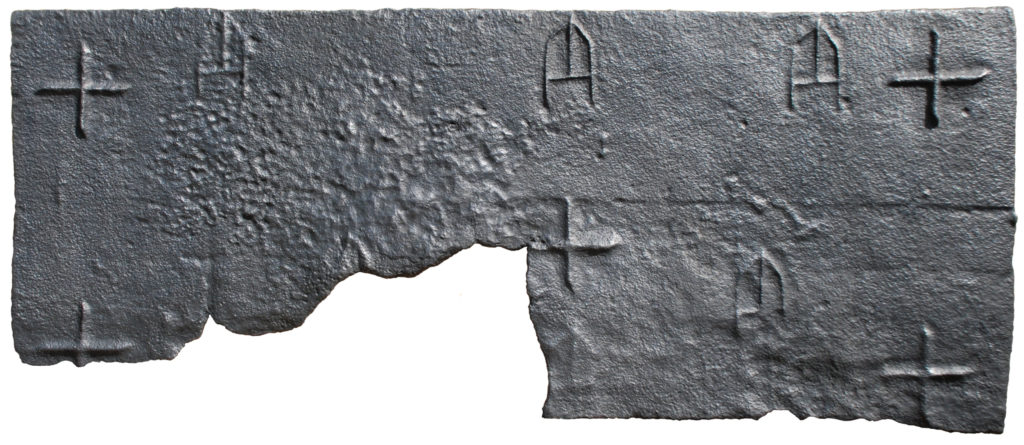
Sir John Pelham (d.1429) had grown up in modest circumstances in Warbleton in Sussex, but rose to become a senior figure in the governments of Henry IV and V and constable of Pevensey Castle, so he was in a position to provide 100 acres of land in his home parish for the canons of the Augustinian Priory at Hastings when their premises became uninhabitable. The new priory was dedicated in 1417. One hundred and twenty years later it would be closed down as a result of the dissolution of religious houses during the reign of Henry VIII. The priory was destroyed but a farmhouse which was constructed soon after, using stone from the demolished buildings, survives to this day.


In 1861 a lengthy paper was published in the Sussex Archaeological Collections tracing the history of the priory at Hastings and its successor at Warbleton. In it the author, the Reverend Edward Turner, noted an iron fireback in one of the fireplaces and included an illustration of the repeated markings on it which were a cross and a Pelham buckle. The use by the Pelhams of a buckle as their badge dates back to an alleged incident at the Battle of Poitiers in 1356 when John de Pelham was among those who captured King John of France, the buckle representing the surrendered sword of the French king.

Pelham buckles appear in a variety of forms on buildings, coats of arms, firebacks (see Pelham family firebacks) and even milestones. The ones on this fireback are unlike any of the others; they are formed of very thin lines, which would be hard to carve as a wooden stamp. The crosses are a bit more substantial and could have been impressed into the casting sand simply as two lengths of wood. My suggestion is that the buckles could have been impressed using a cattle branding iron, a tool that could have been fabricated by a blacksmith and which would necessarily have slender lines to minimise contact with the animal being branded.
What of this fireback’s age? The association of the priory with the Pelhams goes back to the early-15th century but smelting to make cast-iron was not introduced into England until about 1490, so if the fireback had been in the priory buildings before dissolution it would have to have been cast in the early-16th century. It could, of course, have been brought to the priory from another Pelham property elsewhere but the combination of crosses and buckles suggests that it might have been intended for a religious house that was associated with the Pelham family and, as such, could be one of the oldest English firebacks.
I first came across the fireback in 2009. It had been acquired by Ripley Forge and Fireplaces Ltd. of Robertsbridge. I immediately recognised it as the one Turner had illustrated. Having suffered considerable corrosion since the photograph above was taken, it was no longer in a state suitable for resale. They offered it to me in 2015. I cleaned it up and in so doing discovered a mass of iron slag on the reverse of the plate. This had resulted from slag floating on the iron in the furnace hearth not being tapped off completely before the metal was cast, causing some of it to end up on the upcast side of the fireback. Following basic restoration, I gave the fireback to the Sussex Archaeological Society for their museum at Anne of Cleves House, Lewes.
